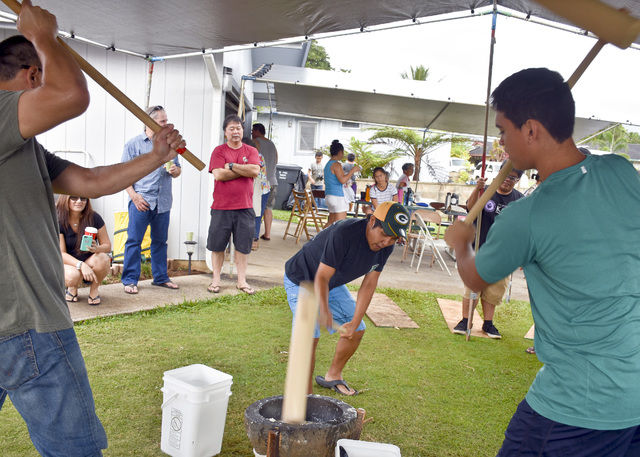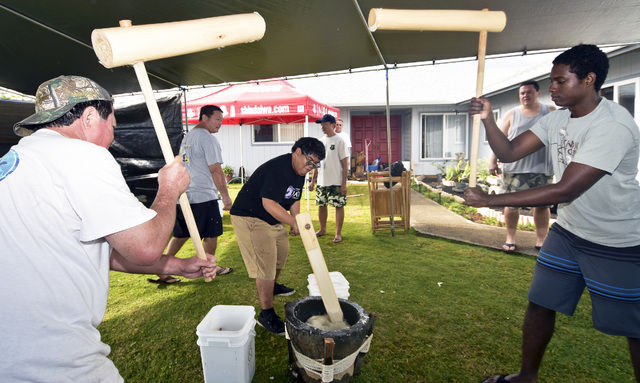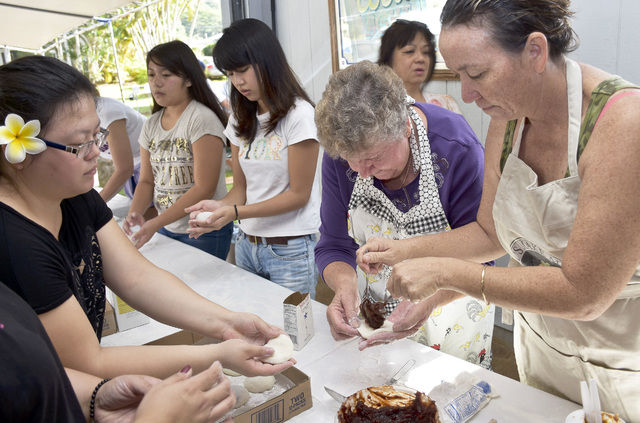WAILUA — Mochitsuki, or the ritual of creating mochi for New Year’s, took on an international flavor Sunday at the Ed Kawamura home in Wailua Homesteads. “I took my turn pounding out the first batch,” Kawamura said. “I always pound
WAILUA — Mochitsuki, or the ritual of creating mochi for New Year’s, took on an international flavor Sunday at the Ed Kawamura home in Wailua Homesteads.
“I took my turn pounding out the first batch,” Kawamura said. “I always pound the first batch just to show them that I can still do it. Now, I’m just helping with whatever needs doing. I did my batch.”
Kawamura was busy repairing kine, or the special wooden mallets created to pound the mochi rice, because he said there were a lot of young people who came to help at the invitation of Masa Tsunekawa, a Kauai Community College student from Nagoya, Japan.
“In Japan, we make mochi after New Year’s,” Tsune- kawa said. “Here mochitsuki is more aggressive — people like to pound the rice. Japan, we pound, touch, pound, but here, everyone just pound, pound, pound, touch, pound, pound, pound.”
Kawamura said the three-man style, as compared with the traditional two-man arrangement in Japan and other parts of Hawaii, allows the rice to turn more, and builds fellowship among the pounders because of the timing required to hit the rice without hitting each other.
“It keeps the rice warm longer,” Kawamura said. “It also means you get softer mochi. Did you have yours yet? You must have mochi before you do anything. This is all about fellowship and talking and getting along.”
The special short-grained mochi rice, after soaking ahead of time for at least a day, is placed into a stone usu, or mortar, where waiting teams of mochi pounders take their turn converting the cooked rice into a sticky blob, which is further cut down by waiting womenfolk.
Some of the mochi brought by people attending the gathering is set aside as divine offerings, labelled Kagami mochi. The two flat round mochi, one larger than the other, are placed on top of each other representing the seat of the New Year gods.
Among the ranks of mochi pounders, Paco Espinosa of Mexico watched as Kawamura juggled between a pull saw and knife to repair a kine which had missed the rice and whacked into the stone usu, or the bucket of water used to turn the rice between pounds.
“This is just like Mexico,” Espinosa said. “We have family, lots of family, dinner with plenty of turkey, ham, prime rib and lots of fireworks. It’s all good stuff.”
Lily Kawamura, Ed’s wife whom he met in Germany, said this annual family event has gone international with the blend of visitors.
“This year, I made nishime,” she said. “Last year, I had German soup. This year it’s nishime with the boiled egg. Make sure you have some for lunch.”
Joining the international menu, someone brought Portuguese Bean Soup to go along with the nishime, fresh mochi powdered with kinako, a soy flour sweetened with sugar, and other local favorites.
Finished mochi is traditionally eaten with the dawning of the new year, placed in a soup called zoni. This practice is steeped in tradition where the Japanese believed that all material objects are imbued with spirits, and by partaking of mochi, symbolizing rice, they hope to gain the strength of the rice gods.




